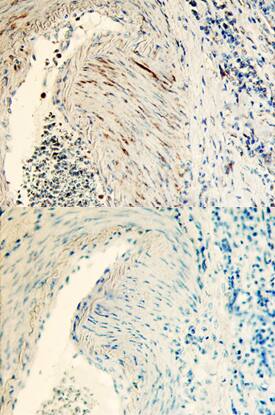Human Tsukushi/TSK Antibody
R&D Systems, part of Bio-Techne | Catalog # AF3940

Key Product Details
Species Reactivity
Human
Applications
Immunohistochemistry
Label
Unconjugated
Antibody Source
Polyclonal Goat IgG
Product Specifications
Immunogen
Mouse myeloma cell line NS0-derived recombinant human Tsukushi/TSK
Thr17-Leu353
Accession # Q8WUA8
Thr17-Leu353
Accession # Q8WUA8
Specificity
Detects human Tsukushi/TSK in direct ELISAs and Western blots. In direct ELISAs, approximately 40% cross-reactivity with recombinant mouse TSK is observed.
Clonality
Polyclonal
Host
Goat
Isotype
IgG
Scientific Data Images for Human Tsukushi/TSK Antibody
Tsukushi/TSK in Human Colon Cancer Tissue.
Tsukushi/TSK was detected in immersion fixed paraffin-embedded sections of human colon cancer tissue using Goat Anti-Human Tsukushi/TSK Antigen Affinity-purified Polyclonal Antibody (Catalog # AF3940) at 10 µg/mL overnight at 4 °C. Before incubation with the primary antibody, tissue was subjected to heat-induced epitope retrieval using Antigen Retrieval Reagent-Basic (Catalog # CTS013). Tissue was stained using the Anti-Goat HRP-DAB Cell & Tissue Staining Kit (brown; Catalog # CTS008) and counterstained with hematoxylin (blue). Lower panel shows a lack of labeling when primary antibodies are omitted and tissue is stained only with secondary antibody followed by incubation with detection reagents. Specific staining was localized to smooth muscle. View our protocol for Chromogenic IHC Staining of Paraffin-embedded Tissue Sections.Applications for Human Tsukushi/TSK Antibody
Application
Recommended Usage
Immunohistochemistry
5-15 µg/mL
Sample: Immersion fixed paraffin-embedded sections of human colon cancer tissue
Sample: Immersion fixed paraffin-embedded sections of human colon cancer tissue
Formulation, Preparation, and Storage
Purification
Antigen Affinity-purified
Reconstitution
Sterile PBS to a final concentration of 0.2 mg/mL. For liquid material, refer to CoA for concentration.
Formulation
Lyophilized from a 0.2 μm filtered solution in PBS with Trehalose. *Small pack size (SP) is supplied either lyophilized or as a 0.2 µm filtered solution in PBS.
Shipping
Lyophilized product is shipped at ambient temperature. Liquid small pack size (-SP) is shipped with polar packs. Upon receipt, store immediately at the temperature recommended below.
Stability & Storage
Use a manual defrost freezer and avoid repeated freeze-thaw cycles.
- 12 months from date of receipt, -20 to -70 °C as supplied.
- 1 month, 2 to 8 °C under sterile conditions after reconstitution.
- 6 months, -20 to -70 °C under sterile conditions after reconstitution.
Background: Tsukushi/TSK
References
- McEwan, P.A. et al. (2006) J. Struct. Biol. 155:294.
- Charpentier, A.H. et al. (2000) Cancer Res. 60:5977.
- Ichikawa, T. et al. 2006, J. Biol. Chem. 281:16927.
- Geng, Y. et al. (2006) Matrix Biol. 25:484.
- Coffy, S. et al. (2005) Biochem. J. 385:165.
- Ohta, K. et al. (2004) Dev. Cell 7:347.
- Kuriyama, S. et al. (2006) Development 133:75.
Long Name
Tsukushin Leucine-rich Repeat Containing Protein 54
Alternate Names
E2IG4, LRRC54, TSKU
Entrez Gene IDs
25987 (Human)
Gene Symbol
TSKU
UniProt
Additional Tsukushi/TSK Products
Product Documents for Human Tsukushi/TSK Antibody
Product Specific Notices for Human Tsukushi/TSK Antibody
For research use only
